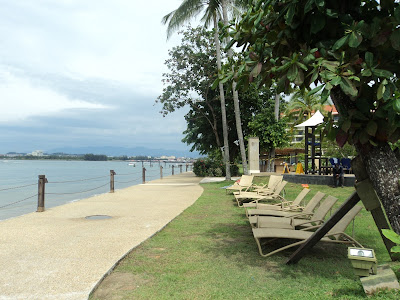My alarm went off at 5am. Outside it was humid and the rain was pattering on the roof of the resort entrance. The 4 of us collected our packed breakfasts and hopped into the cab that took us to the Kota Kinabalu airport for our 7:30am flight to Sandakan!
Getting up early isn't difficult when you have a day of exploring ahead of you.
The Sandakan airport was unlike any other airport I had ever visited. There was no arrivals gate, only a large open air walkway leading to the street where our tour guide held the sign reading "McGrath".
We came to Sandakan to see the Orangutans roaming freely through the Sepilok Rehabilitation Centre.
Every colour of the rainbow was printed onto my pants, with patches of paisley and swirls stitched together. It was no secret I was a tourist.
When we arrived at Sepilok, we were guided through the boardwalks hidden beneath the canopy of rainforest. The trees shook as small monkeys scrambled towards the railings, stopping and staring at us as we walked by. The tour guides repeatedly announced to us all, “Please turn off the flash on your cameras.” A simple flick of the switch is all it takes, but many tourists didn’t bother. So my tip to any Sepilok planners is do the right thing, turn off your flash.
At the viewing platform the sun belted down on us, and I stood waiting for the Orangutans to come swinging in on their ropes for feeding time. The wooden barriers separated us from the 43 square kilometers of protected rainforest, that is home to more than 70 Orangutans. Looking up, there were long ropes tightly intertwined between the trees, creating aerial paths for the ‘wild men’ of Borneo to navigate their way around the forest.
A ranger appeared from the foliage beneath. Climbing up a ladder which was carved into a tall tree where the platform sat, he placed bananas into a large bucket and filled small dishes with milk. Our private tour guide explained that the rehabilitation program provides these orangutans with a monotonous diet of milk and bananas. This bland food is given to them in order to encourage the orangutans to forage for their own food.
The sound of bickering tourists echoed through the Sepilok National Park, as we waited impatiently for the orangutans to arrive. Suddenly, the forest erupted with shrieks sounding from deep within. The ropes leading to the feeding platform vibrated. Someone was coming. I scurried to the front to see who would arrive first.
A large blur of bright orange came swinging off its long, pipe-cleaner arms, making the rope bounce ferociously up and down. From the viewing platform, she appeared to be very large.
Mimi is one of the dominant females at the park. She has a long face and round belly.
 |
| Mimi on the feeding platform. |
A small baby orangutan emerged from behind her, climbing up and wrapping it's arms around her neck.
Another large orangutan came swinging in on the rope for feeding.
We were lucky. My tour guide tapped me on the shoulder whilst I was busy watching Mimi and brought my attention towards four small fingers grasping onto the floor of the platform behind us. An orangutan scrambled to the top of the railings and sat in the corner observing the tourists as they all fixated their attention towards Mimi.
This orangutan was quite close to me, so I remained calm and simply turned to watch him without bothering him.
He remained at peace, resting on his long outstretched arm.
 |
| Contemplating his next move. |
Not long after I had noticed his presence, the rest of the tourists fluttered over, surrounding him, giggling, laughing and fussing over him, just a few metres away from us all.
His kind smile shifted into a smirk. As he bared his teeth, he raised his arms and shrieked loudly. The attention was too much for him to handle. I could almost see him planning a large leap into the crowd, but the guide swept through and grabbed him by the arm, whisking him away while he gnashed his teeth.
Feeding time was up - we had only seen three orangutans. Mum and Dad were disappointed but my aunt was convinced we would see more orangutans on the way out.
When you visit Sepilok, you must remember they are wild, so it isn’t guaranteed that many orangutans will come for feeding. A lot of tourists leave disappointed.
But as we headed back to the tour bus I realised that nobody should leave disappointed. Everybody should appreciate the success of the rehabilitation program, which ultimately proves that the orangutans no longer rely on being fed by humans.








































